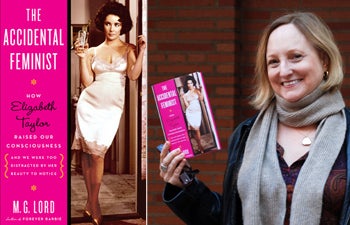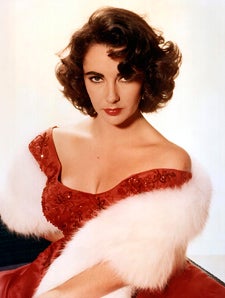Behind Those Violet Eyes
Just for a hoot, M. G. Lord and a group of friends rented a mid-century modern house in Palm Springs, Calif., for Memorial Day weekend.
Lord had brought a box of Elizabeth Taylor movies, and popped in a DVD.
“We were expecting an evening of camp,” said author Lord, an instructor in USC Dornsife’s Master of Professional Writing program. “Instead we were gobsmacked.”
The group was astounded not only by Taylor’s great acting, but by her movies’ feminist messages. After that 2007 weekend, Lord began researching Taylor and her work and wrote The Accidental Feminist: How Elizabeth Taylor Raised Our Consciousness and We Were Too Distracted by Her Beauty to Notice to be released Feb. 7 by Bloomsbury Publishing.
“I was shocked at the feminist themes hidden in plain sight,” Lord said of many of Taylor’s films. “I almost had to see them each twice before I could believe my eyes.”

Written by M. G. Lord (shown here), an instructor in USC Dornsife’s Master of Professional Writing program, The Accidental Feminist: How Elizabeth Taylor Raised Our Consciousness and We Were Too Distracted by Her Beauty to Notice will be released Feb. 7 by Bloomsbury Publishing. A review set to be published in The New York Times Feb. 5 enthusiastically gives the book two thumbs up. Photo by Pamela J. Johnson.
The feminist thread in Taylor’s movies began with National Velvet, her 1944 breakout film at age 12. After Taylor’s character Velvet Brown is forbidden to ride in the Grand National because she is a girl, she finds a way around gender discrimination by posing as a male jockey.
Lord calls Taylor’s 1951 A Place in the Sun an abortion-rights movie. Shelley Winters plays the unwed Alice Tripp who becomes pregnant and tries to find a tactful way to ask her doctor for an abortion. Her doctor refuses and in bitter sarcasm, Alice tells her lover George, “I’m going to have a healthy baby.”
In order to convey the feminist plot about abortion rights without explicitly saying the word, the director needed actors who could express that message — as well as other forbidden concepts — nonverbally. Taylor was a perfect fit. She plays a woman with whom cheater George becomes obsessed.
From 1934 to 1968, the Production Code Administration controlled all movie scripts, and it tried to remove all substance threatening to existing sexual and religious orthodoxy from A Place in the Sun. But the movie conveyed more on screen than on paper because of the nonverbal way Taylor expressed herself subliminally and overtly.
“Taylor spoke directly to our ancient aft brain — our amygdala — the repository of love, hate, fear and lust,” Lord writes. “On paper, in a love scene, having [Taylor’s character] Angela whisper, ‘Tell Mama. Tell Mama all,’ would have seemed inane. In the film, the line … overrides our prefrontal cortex. Like a heat-seeking missile, it hones in on that aft brain.”
Taylor’s most feminist role, Lord said, was as call girl Gloria Wandrous in BUtterfield 8 for which Taylor earned an Oscar in 1960.
“Gloria is a beacon of female sexuality and power,” Lord writes. “She boldly defies marital convention and rejects men who repel her, no matter how much money they offer. She will not be rented like a prostitute or owned like a chattel — or like a wife, for that matter.”
Who’s Afraid of Virginia Woolf? shows what can happen when society permits a woman to define herself only through her children and her husband’s career. In the 1966 film, Taylor’s alcoholic but extremely intelligent Martha is deeply frustrated because she has no children and feels her husband is a failure.
“To me, the film’s feminist message could not have been more explicit,” Lord writes. “Patriarchy crushes men and women alike. But reviewers at the time did not seem to notice this, and some projected their own paranoia onto the movie.”
Lord devotes a chapter to 1963’s Cleopatra in which Taylor depicts the most powerful woman in the ancient world, so could be considered a feminist role. But since the film was a critical failure, Lord dissects its narration and structural problems.
“Cleopatra was a terrible movie,” Lord said. “Joseph Mankiewicz was stuck writing the script while he was filming, so he would shoot up amphetamines and write all night, then direct the next day. So the fact that it’s a tiny bit incoherent is not all that surprising.”
In the book, Lord writes about art imitating life. Early in Taylor’s career, when she performed in films with feminist themes, she may not have been conscious of what she was contributing to. Yet attributes of the characters she played remained with her — and helped to make her the brave, defiant woman she became in later life. Take Taylor’s major impact as an AIDS activist, beginning in the 1980s at a time when even the president of the United States Ronald Reagan had not publicly acknowledged the deadly virus.
“Directors cast her in these powerful roles because they saw something in her that she would finally see in herself,” Lord said.

“Taylor spoke directly to our ancient aft brain — our amygdala — the repository of love, hate, fear and lust,” M. G. Lord writes in her new book The Accidental Feminist.
Taylor’s life work also included some duds — or worse, crudely bowdlerized adaptations of meaningful art — which Lord refused to include in her analysis.
“Some of her films were awful,” Lord said. “One of my ground rules for whether or not I would include a movie was how badly the Production Code Administration bowdlerized the plot until it made no sense.”
For instance, in Cat on a Hot Tin Roof the homosexuality in the original story was censored, Lord said.
“It’s about a man who won’t sleep with his wife because he’s in love with his dead best friend,” Lord said. “Even Tennessee Williams from whom this play was adapted was appalled.”
Lord calls the book The Accidental Feminist because she’s not sure to what extent Taylor chose her parts to make a social statement.
“I can’t read her mind,” said Lord, who in researching the book studied Taylor’s films, interviewed dozens of Taylor’s friends and relatives including Kate Burton, Gore Vidal and Robert Forster to name a few — and drew upon unpublished letters and scripts.
Taylor’s longtime friend and publicist Sally Morrison called Taylor an extraordinary woman and the first in so many ways: first actress to be paid a million dollars (Cleopatra), first celebrity to have a bestselling fragrance (White Diamonds), first famous person to campaign in the fight against AIDS.
“But for those of us lucky enough to have known her, it wasn’t any one of those things that made her so important,” Morrison said. “What was so very unique about Elizabeth was her absolute and unwavering commitment to stand up for the marginalized, the underdog, the ignored.
“Do I think she would have termed herself a feminist? Hell no! But I think she would have been thrilled to think that her films — secretly and subversively — had paved the way for other people to have more choices and more freedoms in their own lives.”
Lord met Taylor once, in 2001 during the dedication ceremony for the Roddy McDowall Memorial Rose Garden, and found Taylor to be a “very intelligent, composed woman,” but that was long before Lord knew she would be writing a book about her.
“This thesis came about accidentally, when I was held hostage in a house and we watched movie after movie,” Lord said.
After seeing the feminist ideas in the films, I thought ‘Why has no one said this before? It’s so obvious.’ ”
Whether readers agree with the premise or not, Lord hopes the book gets people to take a second (or first) look at Taylor’s films.
“I hope this book will move readers to watch the movies it highlights with an open mind, to see if they, too, perceive the feminist content,” Lord writes. “I especially hope the Millennial Generation will watch, catching a glimpse of a recent past in which rights they take for granted — abortion, interracial marriage and certain sexual acts in private between consenting adults — were illegal.”